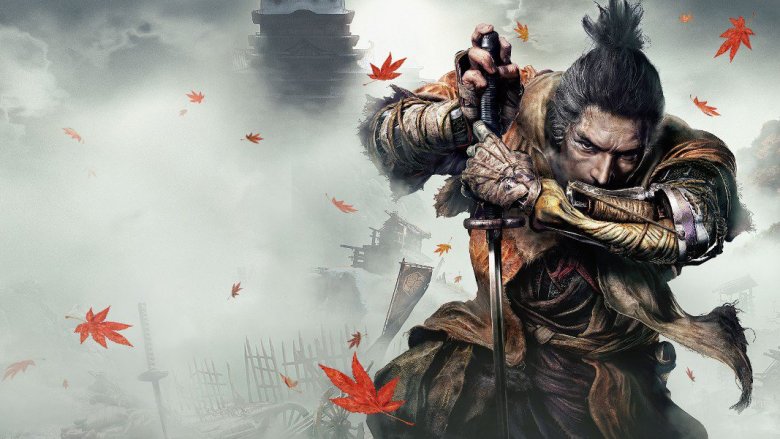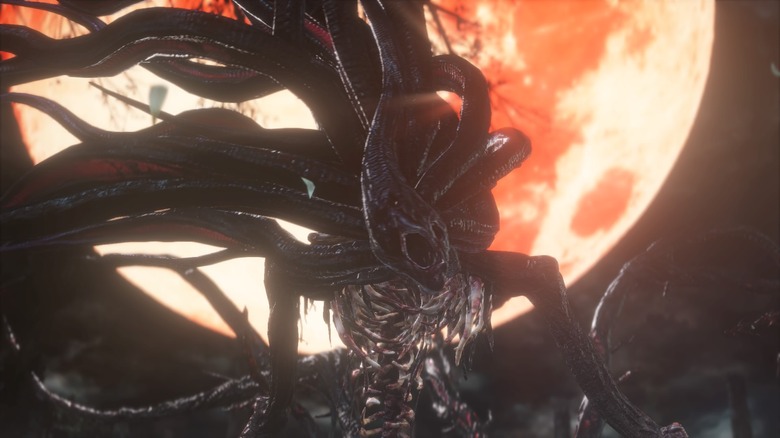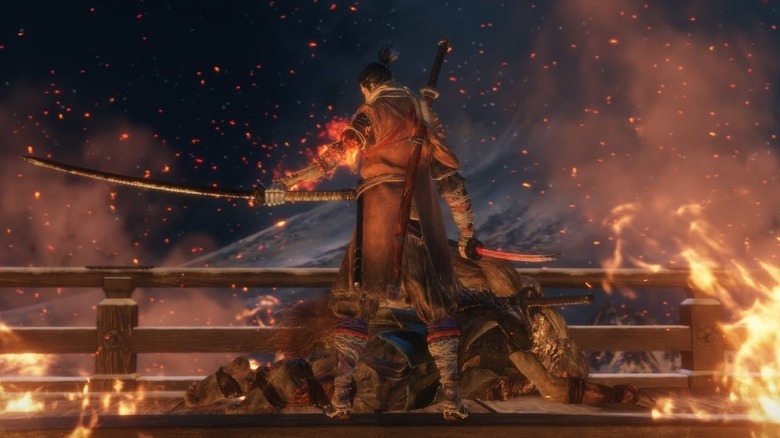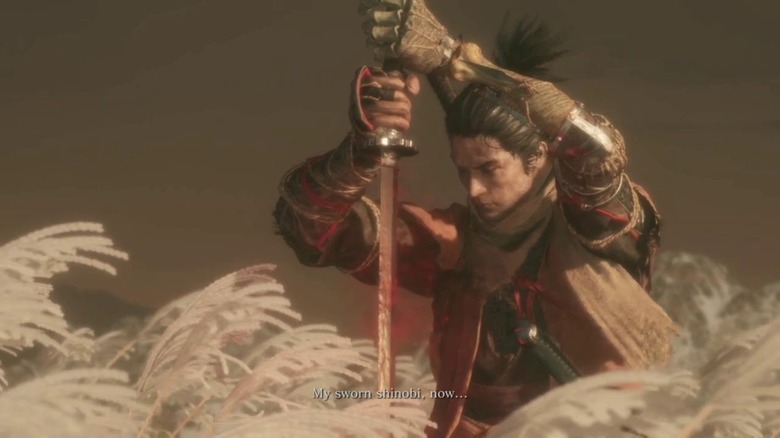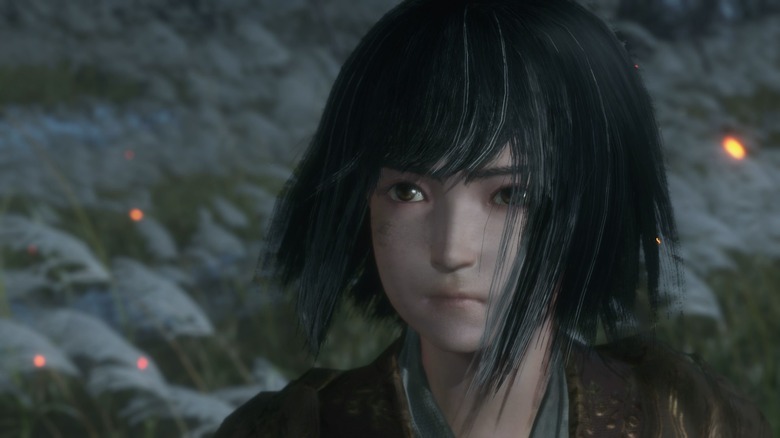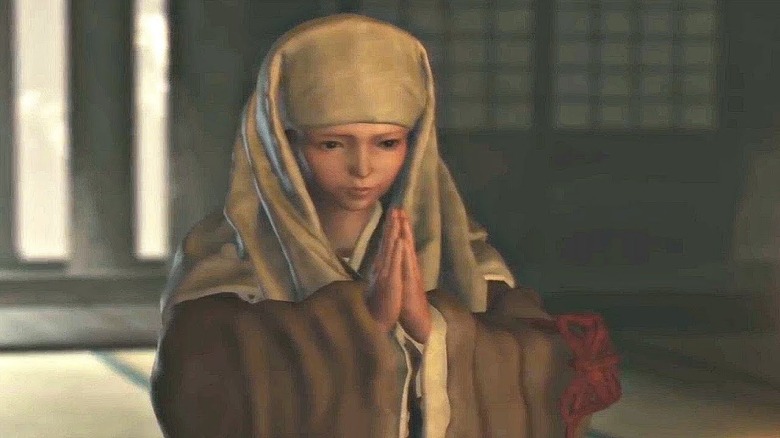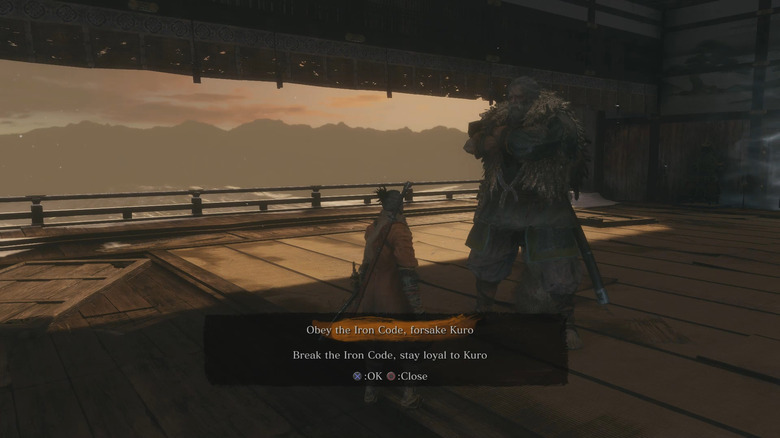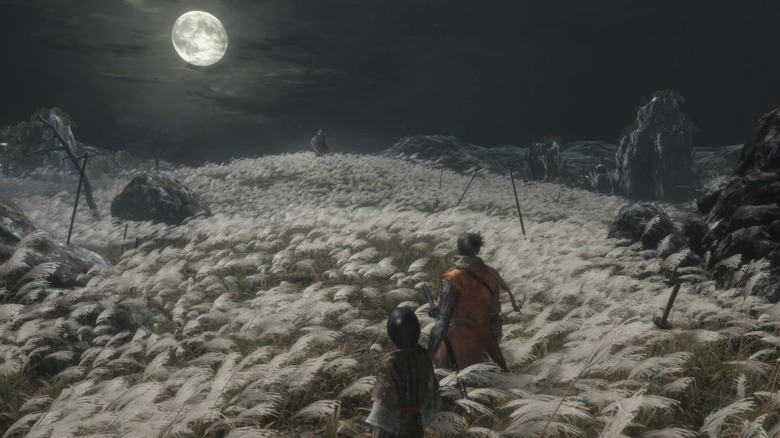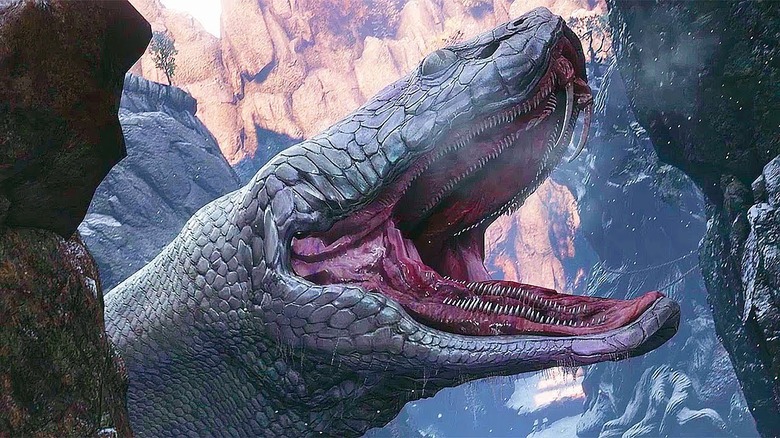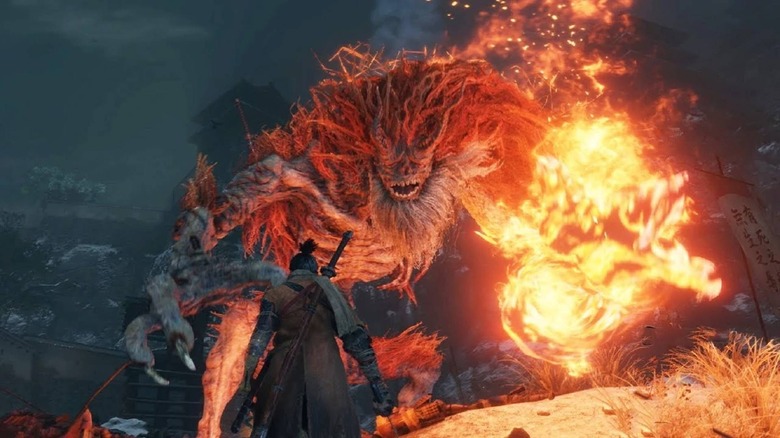Sekiro's Endings Explained
Games from developer FromSoftware aren't exactly famous for being easy to beat. Quite the opposite, actually. We've seen a grand number of rage quit compilations, videos of the most masochistic of gamers taking on certain bosses for the umpteenth time only to get their butts handed to them. Again. And yet, games like Dark Souls and Bloodborne have gathered a dedicated fanbase who were more than ready for some more punishing gameplay when the highly anticipated Sekiro: Shadows Die Twice was released.
Those that put in the hours, mastering their posture and enduring brutal bosses, who finally made it to the end of the game, probably felt a sigh of relief. But these proven shinobi might not have been satisfied with the ending they received. They have questions, and we have answers to the meaning behind the multiple endings of Sekiro: Shadows Die Twice.
FromSoftware is an expert at multiple endings
Since the days of the first Dark Souls game that started it all back in 2011, FromSoftware has been crafting complicated stories that players define the ending to. In the first game, there were just two endings, the player choosing between the machinations of two primordial Serpents ,and neither is exactly a happy conclusion for the player. The second game originally took out this choice, leaving players in a fate they didn't necessarily consent to and causing something of an uproar. This resulted in a patch that provided players with a choice at the end of Dark Souls 2, and a new dedication to multiple endings that has stuck with FromSoftware since.
When Bloodborne came out, FromSoftware included not one, not two, but three endings. The third is not only considered the true ending, but is actually pretty challenging to achieve. Duking it out with the final-final boss and turning into a squid is therefore something of a secret, alternate ending. Dark Souls 3 added yet another possible conclusion, leaving completionists with the gargantuan task of four separate playthroughs. Sekiro: Shadows Die Twice sets up that same challenge, each with wide-reaching implications.
What exactly does Shura mean?
The easiest ending is naturally the worst ending to get, if you're attached to the One-Armed Wolf anyway. After Wolf has traveled around gathering the items needed for the Immortal Severance ritual, he will return to the top of Ashina Castle, where The Owl waits. The Owl, Wolf's adopted father, presents him with a terrible choice: follow either the Iron Code or Kuro, the Divine Heir.
This choice essentially pits Wolf between the two most important people in his life. He is loyal unto death to Kuro, his master, but The Owl raised him, taking him under his massive wing and teaching him the ways of the shinobi. One of those ways is the Iron Code. In this case, the relevant part of this mantra is that, in The Owl's words, "As your father, my word is absolute. Your master's is a close second."
By following the code, players can choose to forsake Kuro and follow The Owl. Upon defeating Emma and the aged Isshin, The Owl reveals that he is something of a megalomaniac, saying that the whole country is theirs for the taking. Except, his plans are cut short by a quick stab in the back from his own Wolf. He gasps the word, "Shura!" before collapsing. In Buddhism, an ashura is an unhappy rebirth, the person reborn now obsessed with violence and consumed with anger. Wolf has become a demon of bloodlust, and he goes on to kill thousands, soldiers and townsfolk alike.
This ending occurs much earlier in the game than any of the others, making for the shortest complete playthrough.
Kuro's wish: the Immortal Severance ending
The power of the Divine Heir is what has caused the main conflict of the game. Genichiro Ashina wants to use his power to create an immortal army to bring the Ashina clan back from the brink. Kuro, the Divine Heir himself, makes the decision that it would be best to get rid of his divinity so that there would be no more fighting. The Owl, reappearing after Wolf had thought he'd been killed, is also after this power and demands that Wolf forsake his master. Choosing not to, The Owl breaks down crying at Wolf's betrayal before attacking.
To get the Immortal Severance ending, Wolf must defeat his father. Then players will have to make their way through the Fountainhead Palace, no easy feat, and go to the Divine Realm in order to defeat the Divine Dragon and obtain the Divine Dragon's Tears to give to Kuro. Sekiro isn't done with you just yet, though. Genichiro is stubborn, and has a Mortal Blade of his own that he uses to summon his grandfather Isshin at the height of his power upon defeat. This final boss is, true to FromSoftware form, incredibly difficult to beat, and victory is bittersweet. Kuro has been wounded, and severing his ties to his Divine Heritage, his immortality, is as good as a death sentence. Wolf's final act of loyalty to his young master is killing him. Wolf becomes the next Sculptor, his Shinobi Prosthetic set aside for the next shinobi to come seeking power.
Wolf's sacrifice: the Purification ending
The third option, called the Purification ending, is a variant of the Immortal Severance. Immortal Severance, and thus his death, is what Kuro desires, but Wolf has some qualms with this. And so does Emma, Isshin's attendant. They talk and agree to try to find a path in which Kuro need not die. Finding out how requires an awful lot of eavesdropping, but Wolf manages to find out that he will need the Everblossom flower in order to both sever Kuro's ties to his Divine Heritage and keep him alive.
Getting the Aromatic Flower item requires fighting the memory of The Owl again at the Hirata Estate. Rather than a bare branch, his memory instead gives a flowering branch. To get the Purification ending, Wolf has to give Kuro both the Divine Dragon's Tears and the Everblossom. But oh no! Kuro was stabbed by Genichiro, and with his new mortality, he is mortally wounded. Wolf is loyal to a fault, and wishes for his master to live.
This shinobi has one last play to make, but it is one that requires great sacrifice. The Mortal Blade is connected to the land of the dead. A sacrifice can bring back someone to the land of the living, as Genichiro did to summon his grandfather. "May you live on, and embrace what it means to be human," are Wolf's last words before he cuts into his own neck with the Mortal Blade, allowing Kuro to live a normal life.
The Divine Child's gift: The Return ending
The Dragon's Homecoming or The Return ending is a secret option, just as bittersweet as the rest, but more difficult to achieve. Specifically, this ending requires the help and sympathy of the Divine Child of Rejuvenation. In order to get The Return, players will have to first find a book called Holy Chapter: Infested, which mentions that the holy dragon's origins are in the west. Give her this book and take all the rice you can get from her, refreshing the area after each meal. Eventually, she will become sickly. You can heal her with a persimmon and the next time she gives rice, it will be as a gift for Kuro. Kuro makes a sweet rice ball from the rice for Wolf, and telling the Divine Child about this will make her think of another path to take.
The Holy Chapter: Dragon's Return, which the Child will now require, tells her of a way to save Kuro by sending the Dragon's power back to its birthplace. For this ritual, she needs to consume persimmon-like Fresh Serpent Viscera and Dried Serpent Viscera, which can be obtained by killing one Great Serpent and tricking another. Eating them will allow her to shed Frozen Tears for Kuro. Giving them to him with the Divine Dragon's Tears will allow his spirit to be cradled in the Divine Child so that she, and Wolf, can take him to the west, and return the power of the Dragon's Heritage there.
Which ending is the true ending?
Knowing that there are many paths to walk, each with very different endings in store for Wolf and his young lord Kuro, which ending is the true ending? All of them make sense given the choices that lead to their execution. For Wolf to follow The Owl, he would have to become a monster. Wolf, if he's ultimately loyal to Kuro, has to kill his master in order to exact Kuro's wishes. And for Kuro to live on, as a mortal, Wolf would have to make the ultimate sacrifice. This leaves us with the ending in which they both live. Sort of. The Return ending keeps Wolf intact while Kuro lives on within the Divine Child, all the while working toward the aim of keeping any more blood from being shed over the power of the Dragon's Heritage.
The Return is arguably the best ending, marginally the happiest for Wolf. No suicide or murder sprees, and with a hope for the future. Maybe with hope for future games, too, which gives it the best shot at becoming canon.
Do we think this hints at a sequel?
Given the way that The Return ending, well, ends, there is evidence to suggest that there may be a sequel to Sekiro: Shadows Die Twice. Wolf and Kuro's journey is not yet over, as it turns out, but rather just starting. In the final cutscene, the Divine Child says that they are about to embark on a journey to sever their ties to destiny, thus freeing Kuro from his Heritage, even if he's not necessarily corporeal anymore. Wolf still serves him, and will accompany the Divine Child on the long journey to the west.
The phrase "journey to the west" may sound familiar. Fans, hearing this, were convinced that should a Shadows Die Thrice game be released, it would be a retelling of the centuries old Chinese story of The Journey to the West, which notably involves a dragon prince. The lore contained within the 100-chapter novel would be great material on which to base a new game: there are plenty of fights, strange creatures, and adventures that could translate into the frustrating, precise experience of a FromSoftware game. We haven't yet had any indication from the developers themselves if Sekiro will follow in Dark Souls' footsteps with follow-ups, but there is certainly hope to be had.
Which is ending the hardest to get?
The thing about FromSoftware games is that there is no easy end. All of them require hacking through boss after boss before facing a battle that will take a considerable amount of time, patience, and tears. This stays true in the case of Sekiro: Shadows Die Twice. Isshin, the Sword Saint, is unholy in the amount of power and mastery he holds over the blade. Players must first fight and defeat him in order to make the choice of which ending they get. (Unless they succumb to the Shura ending. Things are cut short in that case.)
In order to get the option to save Kuro, there are quite a few extra hoops to jump through, like defeating The Owl a second time and doing some ninja eavesdropping. Whereas The Purification ending might be stumbled upon by players who are true to the sneaky nature of shinobi, the Return ending ... look, you just have to follow a guide. There is little opportunity within the game itself to intuit your way through. How are we supposed to know that you have to eat all of the Divine Child's rice to get her to consider becoming a cradle for Kuro's spirit? Reading from the Holy Chapters might hint at the Return ending, but triggering it requires a little outside help.
What to do after beating the game
Ready for more punishment? If you weren't entirely satisfied with the ending you received in Sekiro: Shadows Die Twice, there is always the option to try again. And again. FromSoftware encourages trial and error, error, error. Combat takes some time to get used to, but if you feel like a master swordsman from one playthrough, the New Game Plus provides a new challenge and opportunity for players. The enemies will hit harder than ever before, but you have the chance to change Wolf's fate and try out another ending in this new playthrough.
Plus, you can build a new Wolf. There are five skill trees to level, with the addition of esoteric texts scattered in the game that can unlock secret techniques. Get ahold of these, and you can become an all-new shinobi. You might want to try these powers out on the bosses that you missed along the way. There are many monsters and enemies you can skip on the initial playthrough, since these creatures are unneeded for Wolf's mission. But a second playthrough will give players the chance to blunt their blades on never-before-fought baddies. Because, let's be real, if you're playing the game for a second time, you're probably a fan of the epic struggles in a good FromSoftware boss fight. Masochist.

